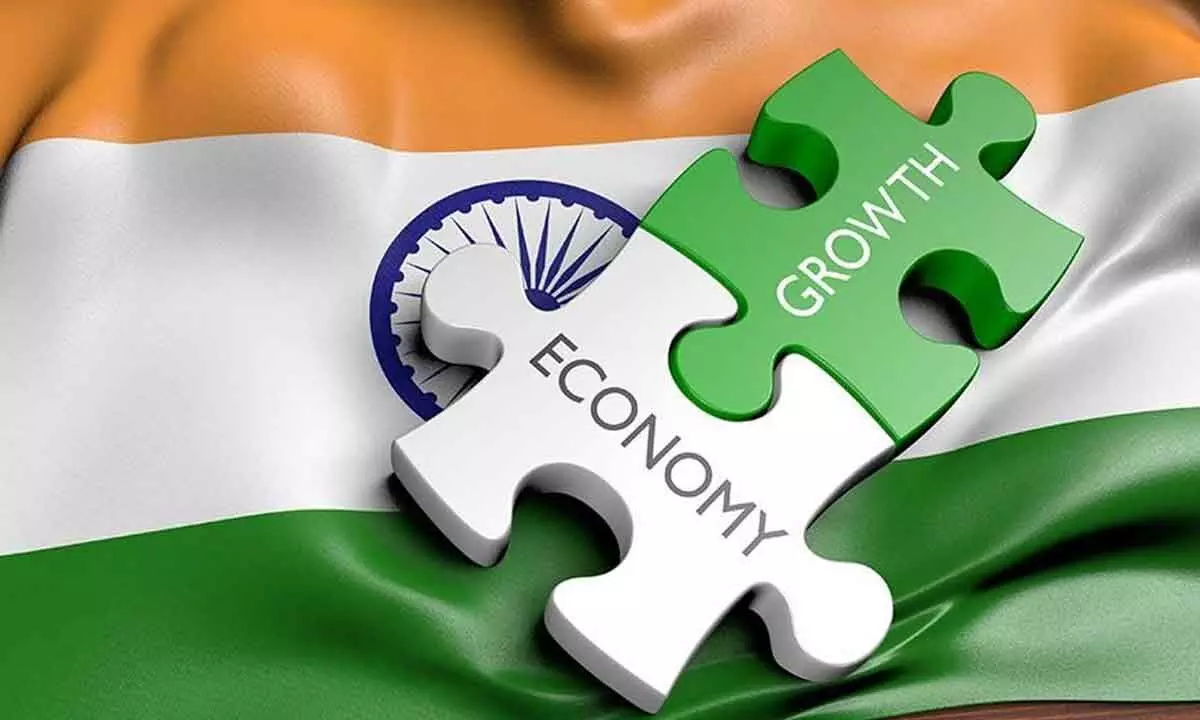Non-productive sectors dictating GDP growth rate, driving India’s recovery
Recent numbers seem impressive but they are not as remarkable when we look at the bigger picture
image for illustrative purpose

The report pointed out that similar to the trajectory of any developed country, India's GDP growth over the last decade has seen a decline in the primary sector (agriculture and related activities), whose share in Gross Value Added (GVA) has declined from 18.5 per cent in 2011-12 to 15.1 per cent in 2022-23, but a complementary rise in the industrial sector, which could boost productivity, has not occurred.
A study paper on India's economic growth, underscoring the slow recovery from the pandemic, dominance of non-productive sectors in driving growth and imbalanced investment patterns should make one pause and reconsider the growth strategy before celebrating.
The paper by L.T. Abhinav Surya from the Centre for Development Studies (CDS) points out that everyone is buzzing about India's economic growth predictions for 2023-24, expecting a good year ahead after experts from RBI and IMF backed the optimism, projecting a solid 6.5 per cent and 6.3 per cent growth rate, respectively.
"The recent figures on the Gross Domestic Product (GDP) in the first half of 2023-24 seem promising, indicating a robust 7.7 per cent growth compared to the previous year. Many are praising India as a key player in the global economic rebound post-pandemic. In realistic terms, India's share of the world GDP has increased from 3.25 per cent in 2019 to 3.39 per cent in 2022, a rise of 14 basis points. On the other hand, between 2016 and 2019, it increased by 24 basis points, from 3.01 per cent to 3.25 per cent,” reads the report.
Going further Surya's study points out that “the growth rate hasn't been significantly higher post-pandemic compared to before it. Moreover, there are concerns about persistently high unemployment rates, rising inflation, and other social and economic issues that don’t always get highlighted in these big headline numbers".
Looking into the growth in perspective, he points out that the country’s GDP took a hit before and during the pandemic, so the current spike in growth isn’t entirely unexpected.
"When we look closely at the numbers, the annual GDP growth rate has been a sluggish 3.27 per cent between 2019-20 and 2022-23. This indicates a slow recovery from the Covid-19 shock. Even comparing the GDP between the first half of 2023-24 and 2019-20, the average growth rate has been only 3.65 per cent. So, while the recent numbers seem impressive, they are not as remarkable when we consider the bigger picture," he says.
Explaining in detail, the report pointed out that similar to the trajectory of any developed country, India's GDP growth over the last decade has seen a decline in the primary sector (agriculture and related activities), whose share in Gross Value Added (GVA) has declined from 18.5 per cent in 2011-12 to 15.1 per cent in 2022-23, but a complementary rise in the industrial sector, which could boost productivity, has not occurred-its share has remained stagnant at around 22 per cent.
"What's worrisome is that the share lost by the primary sector has been absorbed mainly by the real estate sector, which many experts consider non-productive. Its share has risen from 18.9 per cent in 2011-12, to 21.9 per cent on the eve of the pandemic in 2019-20, to 22.5 per cent in 2022-23. This means the value created in other sectors often ends up being redirected into these areas without creating new value. Even during the pandemic, this sector had shown growth while the others struggled. In the first half of 2023-24, with an 8.8 per cent year-on-year growth, it has been leading the rebound in growth. This shift should be a cause for concern rather than celebration," Surya cautions.
The study adds that some might highlight the growth in the manufacturing sector post-pandemic, but it must be remembered that it had already seen a downturn before the pandemic. Hence, the actual annual growth rate of three per cent between 2018-19 and 2022-23 and 3.76 per cent between the first half of 2018-19 and 2023-24, isn't as high as it might seem.
This is also reflected in the manufacturing sector's Index for Industrial Production (IIP), whose growth rate has been much lower in comparison to the pre-pandemic period. Hence, the numbers indicate that the non-productive sectors are the ones driving the recovery.
Yet another aspect drawing attention is investment, measured by Gross Fixed Capital Formation (GFCF). Its share in GDP, after witnessing a prolonged period of decline from 34.3 per cent in 2011-12 to 31.1 per cent in 2020-21, bounced back recently, reaching 35.3 per cent in the second quarter of 2023-24, mainly due to increased government capital expenditure.
However, this rise in government investment has come at the expense of reduced investments by public corporations, leading to stagnation in the overall public investment ratio.
The study adds that most of the increased investment has been in infrastructure, which is beneficial but primarily reduces costs for businesses.
If the current growth in fixed investment is a continuation of this trend, our long-term success might be at risk. He concludes stating that it isn’t time yet for stating celebrating.

